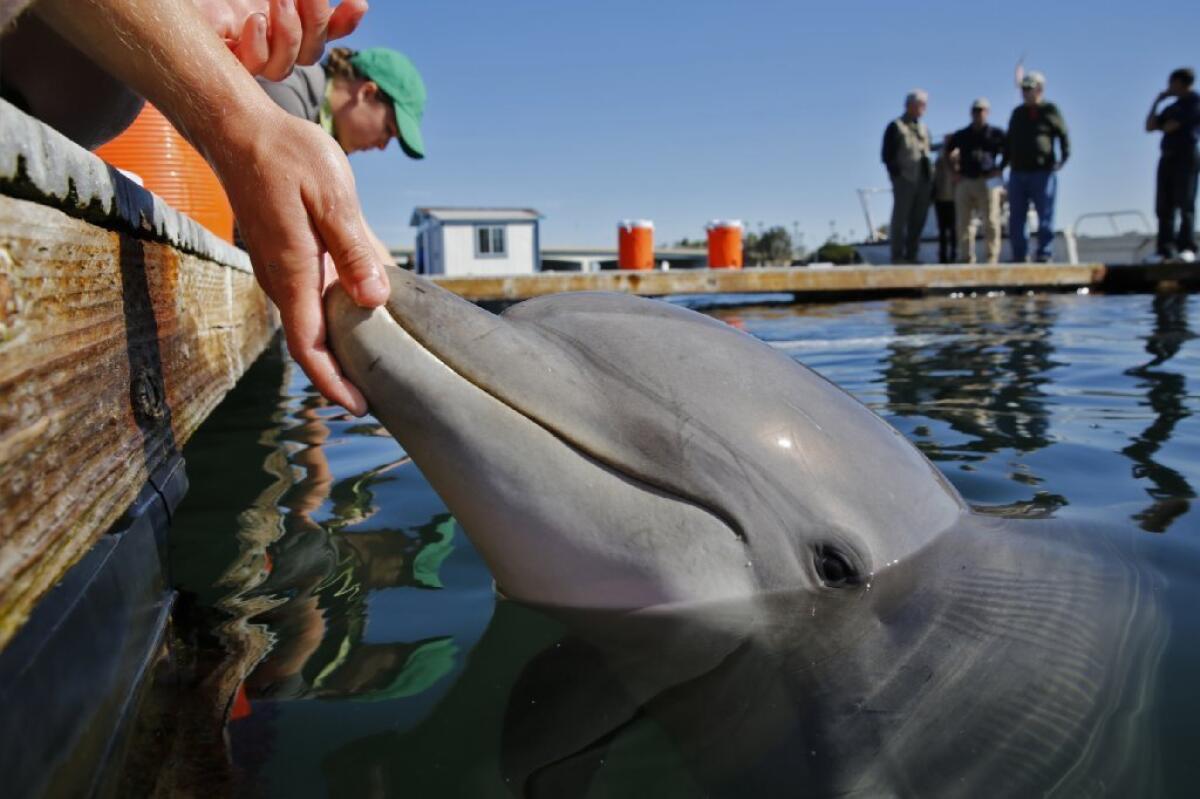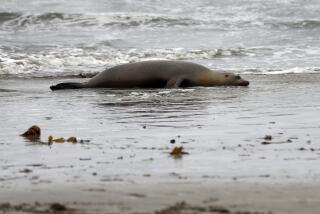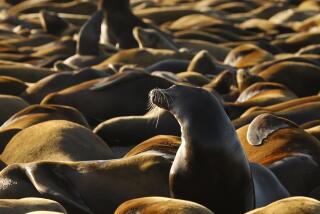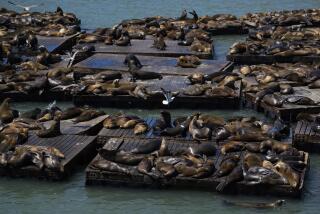Dolphins, sea lions train for Navy deployment to overseas trouble spots

- Share via
Reporting from San Diego — For a moment, the mammal and the machine are side by side on a Navy dock here.
The dolphin and the drone — and their respective handlers — will spend the morning training for a possible order to deploy to the Persian Gulf or some other international trouble spot to detect underwater mines, or maybe to guard a port against a terrorist threat.
The mammal is Puanani, a bottlenose dolphin, a sleek 7 feet, 10 inches long and 427 pounds. The machine is an Unmanned Underwater Vehicle, or UUV, Kingfish version, 11 feet long, 600 pounds.
Puanani was born in the Gulf of Mexico and received initial training from the Navy in Hawaii. The cigar-shaped UUV was built by Hydroid, Inc., a Massachusetts-based defense contractor.
Both are assigned to a mission that Navy officials say is increasingly critical: maintaining “underwater dominance” and the ability to thwart attacks aimed at the home front or at U.S. and allied ships in foreign locations. Among potential targets, the Navy’s top admiral warns, is the port at Long Beach.
The U.S. has submarines, advanced sonar aboard surface ships and high-tech scanning capability aboard aircraft — as well as listening devices beneath the waves and an untold number of technological and intelligence-gathering assets that are classified.
In San Diego, with a budget of $28 million a year, the Navy has 90 dolphins and 50 California sea lions in a program run by the Space and Naval Warfare System Pacific. Nearly every day the animals train in San Diego Bay or in the ocean beyond Point Loma. There are also several UUVs.
The dolphins and the sea lions, using their keen eyesight and “biological sonar,” are expert at finding mines.
The sea lions are also trained to detect any swimmer who is in a restricted area. The animal clamps a “bite plate” on the swimmer’s leg and takes the attached tether back to his handler.
That’s the exercise that veteran trainer Chris Harris is conducting with Joe, a sea lion who has made multiple deployments including to the Persian Gulf.
Harris signals Joe to begin his dive. Within a minute, Joe has surfaced, followed by a Navy diver playing the part of a would-be terrorist. The diver gives a thumbs up. Joe has done his job.
Harris gives Joe an enthusiastic attaboy, and tosses a fish into his mouth. “He’s robust and he’s reliable,” Harris said.
Puanani was sent to the Persian Gulf during the invasion of Iraq. “She is deployable anytime, anywhere,” said Mark Patefield, Puanani’s lead trainer. “All we need is the word ‘go.’ ”
Sea lions are amphibious and can essentially hop into a small boat. The dolphins are lifted in a sling. On a transport plane or ship, the sea lions are kept in specially designed enclosures that are cool and wet. The dolphins travel in fleece-lined stretchers suspended in fiberglass containers filled with water.
The UUVs are currently deployed to the Persian Gulf and to the area patrolled by the Japan-based 7th Fleet. They have also assisted in search missions, including the Challenger disaster and Hurricane Katrina.
Sea lions and dolphins guard bases at Kings Bay, Ga., and Bangor, Wash., where the Navy’s nuclear-armed Trident submarines are located. The Persian Gulf is a particular focus of the U.S. because of threats by Iran to mine the waterway.
Someday the UUVs may replace the mammals in the mine-detection mission. Until then they share the assignment.
“The mammals are the best at what they do,” said Mike Rothe, manager of the marine mammals program. “They’ve evolved over thousands of years to have a remarkable sonar. We’ve been developing the UUVs for several decades.”
The first dolphin trained in mine detection was Notty in 1960. President John F. Kennedy liked the idea of using sea creatures for military purposes and the program expanded.
Dolphins and sea lions helped guard the ammunition piers at Cam Ranh Bay during the Vietnam War. Sharks and whales were found to be untrainable.
Each training day begins with an assessment of the animals’ attitude, appearance and appetite. “Every day we interact with the animals,” Harris said.
The program has male and female dolphins, and thus an occasional birth occurs. The sea lions are all neutered males. The newest sea lions are the nine caught off San Nicolas Island in 2013.
Dolphins and sea lions can dive to depths of several hundred feet and, unlike humans, do not suffer from the potentially fatal condition known as the bends when they surface. They are natural hunters, although getting them ready to deploy can take several years. “You need to build up trust,” Patefield said.
Dolphins are prone to respiratory problems; sea lions to cataracts. A dolphin had kidney stones removed recently. At a veterinary hospital on base, Army veterinarians are assigned to care for the mammals.
In the 1974 movie “The Day of the Dolphin,” dolphins were stolen by extremists who wanted to use them to blow up the president on his yacht.
For decades, the Navy has said its marine mammals are not offensive weapons, and are not trained to carry explosives. A presidential commission came to the same conclusion.
During the 1996 Republican convention in San Diego, dolphins were assigned to guard GOP yachts.
During training as well as deployments, nothing forces the dolphins and sea lions to return to the handlers’ small boats. But they have learned where their food is dispensed.
“They are large, smart, socially complex mammals with a mind of their own,” said Mark Xitco, supervisor of the program’s scientific and veterinary support branch. “We can’t force them to do anything they don’t want to do.”
Nitro, a dolphin who was considered a mine-hunting “star” at the recent multinational exercise off Hawaii, was making squeaking sounds on a recent morning.
“That’s a good sign,” said Nitro’s lead trainer, Amanda Naderer. “He’s ready to go to work.”
More to Read
Sign up for Essential California
The most important California stories and recommendations in your inbox every morning.
You may occasionally receive promotional content from the Los Angeles Times.










